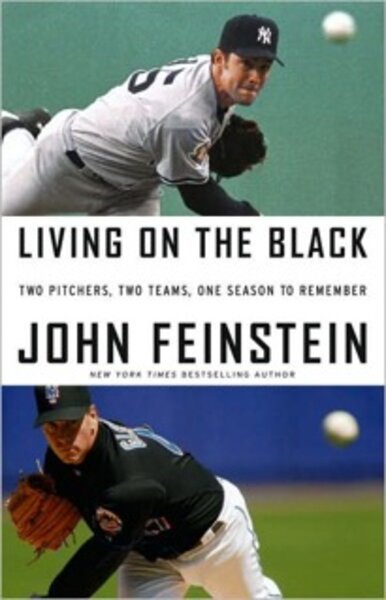Living on the Black
Loading...
John Feinstein uses a simple but effective method to take fans inside the world of big-time professional sports. He makes friends with an athlete or two, earns their trust, and then bores in for a year-long look at their lives.
Beginning with his smashing debut in 1986, Feinstein established himself as the brand name in sports books. That debut, “A Season on the Brink,” detailed the exploits of Indiana University basketball coach Bobby Knight and the misery he inflicted on his players, campus administrators, reporters, and many others in pursuit of wins and high graduation rates. It was the sports equivalent of “All the King’s Men,” a relentless meditation on whether the ends justified the means.
Once the Knight book made Feinstein an A-list author, he encountered the perks and pitfalls inherent in the rarefied air of bestsellerdom. Much like novelists John Grisham and Stephen King, you can count on at least one Feinstein offering every year. And, just like Grisham and King, his prolific output and strong sales have often led to uneven efforts and an all-too-frequent dearth of significant editing.
With Living on the Black: Two Pitchers, Two Teams, One Season to Remember, Feinstein writes the way one of his subjects, veteran baseball finesse artist Tom Glavine, pitches: with decided skill, but a skill that often takes time to find its mark and often involves working out of self-inflicted trouble. Here, however, Feinstein benefits from an astute pairing of pitchers to follow during the 2007 baseball season: Mike Mussina of the Yankees and Glavine, the erstwhile Met.
Both have had stellar careers – Glavine is a certain Hall of Famer and Mussina is borderline for Cooperstown – and both are known for their cerebral approach to the game.
That they offer the yin-yang of being a right-hander (Mussina) and a lefty (Glavine) and were playing for pressure-cooker teams in a rabid baseball city only enhances their appeal.
The pitchers and many of their teammates and coaches provide Feinstein with extensive access and detail on what it takes to play professional baseball. The constant adjustment – the daily mental grind, the injuries, and the relentless uncertainty of whether this slump is merely another slump or the end of a career – all come across in a barrage of anecdotes and interviews.
The season Feinstein followed the pitchers around included Glavine’s historic 300th career win, the Mets’ epic late-season collapse that cost the team a playoff berth, and the Yankees’ first-round playoff loss that led to the departure of manager Joe Torre.
Details abound: how many warm-up tosses Glavine and Mussina favor, what pitches they throw during warm-up sequences, the long-toss sessions between starts, where they hide to watch the rest of the game unfold after being removed. We learn that both Mussina and Glavine have used the dietary supplement creatine, but not, apparently, steroids or human-growth hormone.
Feinstein explores baseball’s drug problem in brief asides, but never really pushes his subjects beyond generalizations (the pitchers are more surprised at who isn’t doing steroids than who is) to discuss players in the game who have admitted guilt or are believed to have used illegal substances. Mussina often mentions his long-time teammate, the now-notorious Roger Clemens, in other contexts but never on the topic of steroids. Did
Feinstein fail to ask or did Mussina decline to answer? After 500 pages, I still don’t know.
Chasing a career milestone (Glavine) and the playoffs (the Mets and Yankees) offers drama and Feinstein works hard to sustain that tension. Still, with the memories of those events still so fresh it’s asking a lot of the reader to engage in what-if scenarios when the answer has been so recently established.
It is a task exacerbated by the current economics of baseball and other major spectator sports. The money has gotten so big that it’s become difficult to say the stakes are as high as they once were. The jobs remain precious, the players want to win badly, but, let’s face it, guaranteed contracts worth millions of dollars (Glavine will earn $8 million in 2008 and Mussina $11.5 million) have altered the landscape.
Feinstein’s book delivers extensive evidence on both sides of this paradox: The players strive and gnash their teeth to perform and stave off slumps even as they count their millions and realize their worst days are almost always far better than the best days of the fans paying to watch them play. With that, Feinstein achieves a double play fans should savor for its scrupulous look at what life is like for the 21st-century major leaguer.
Erik Spanberg is a freelance writer in Charlotte, N.C., and a life-long Chicago Cubs fan.






